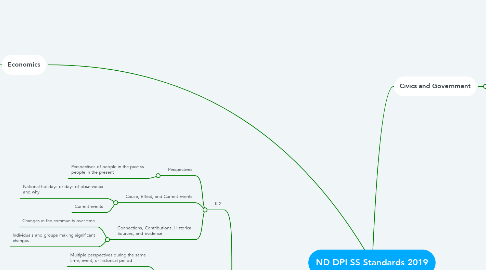
1. Economics
1.1. K-2
1.1.1. Exchange and Markets
1.1.1.1. Characteristics of the American economy
1.1.1.2. Producers and Consumers
1.2. 3-5
1.2.1. Exchange and Markets
1.2.1.1. Goods and Services Produced
1.2.1.2. Principle concepts of economics
1.2.1.3. Factors that influence savings and spending
1.2.2. National Economy
1.2.2.1. North Dakota's resources affect its economy
1.2.2.2. Natural resources affecting different states
1.3. 6-12
2. History
2.1. K-2
2.1.1. Perspectives
2.1.1.1. Perspectives of people in the past vs. people in the present
2.1.2. Cause, Effect, and Current Events
2.1.2.1. National holidays or days of observance and why
2.1.2.2. Current events
2.1.3. Connections, Contributions, Historical Sources, and Evidence
2.1.3.1. Changes in the community over time
2.1.3.2. Individuals and groups making significant changes
2.2. 3-5
2.2.1. Perspectives
2.2.1.1. Multiple perspectives during the same time, event, or historical period
2.2.1.2. People's perspective shaping history
2.2.1.3. North Dakota Native Americans
2.2.2. Cause, Effect, and Current Events
2.2.2.1. National holidays or days of observance affect United States and the impact
2.2.2.2. Causes and Effects of Global events and developments in relation to North Dakota
2.2.2.3. Causes and Effects of Global events and developments in relation to United States
2.2.3. Connections, Contributions, Historical Sources, and Evidence
2.2.3.1. Cause and Effect with relationships among historical events in United States
2.2.3.2. Primary and Secondary Sources
2.2.3.3. Individuals contributing to the United States
2.2.3.4. Individuals and Groups contributing to North Dakota
2.2.3.5. Statehood of North Dakota
2.3. 6-12
3. Civics and Government
3.1. K-2
3.1.1. Origin, Purpose, and Function of Civics
3.1.1.1. Purpose of rules, laws, and positions of authority
3.1.1.2. Why people form governments
3.1.2. Roles and Involvement of United States Citizens and Residents
3.1.2.1. Ways citizens can participate in government
3.1.2.2. Important rights and responsibilities
3.2. 3-5
3.2.1. Origin, Purpose, and Function of Civics
3.2.1.1. Structure of government of United States
3.2.1.2. Structure of government of North Dakota
3.2.1.3. Responsibilities and power of government officials
3.2.2. Roles and Involvement of United States Citizens and Residents
3.2.2.1. Procedures for making decisions
3.2.2.2. Personal and Civic responsibilities
3.3. 6-12
4. Geography
4.1. K-2
4.1.1. Geographic Representation
4.1.1.1. Constructing maps with symbols, labels, and legends
4.1.2. Human and Environment Interactions
4.1.2.1. People vs. Physical environment
4.2. 3-5
4.2.1. Geographic Representation
4.2.1.1. Constructing maps of familiar and unfamiliar places
4.2.1.2. Use geographical tools to report information from spatial perspective
4.2.1.3. Use maps to explain relationships between locations
4.2.2. Human and Environment Interactions
4.2.2.1. North Dakota's regions have been affected by physical and human characteristics
4.2.2.2. 3 geographical regions of North Dakota
4.2.3. Human Population: Spatial Patterns and Movements
4.2.3.1. Patterns of human settlements in North Dakota
4.2.3.2. Patterns of human settlements in United States.
